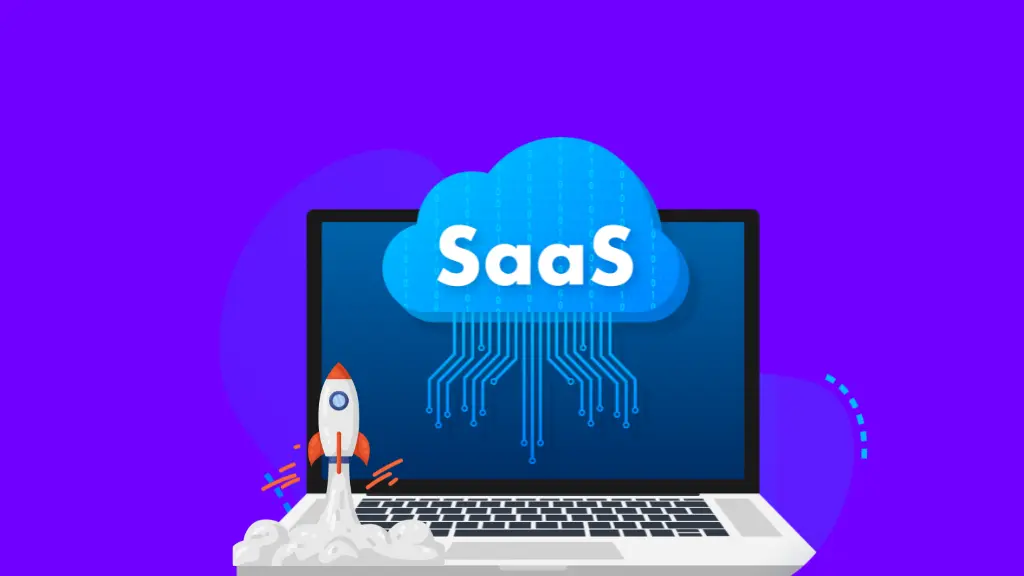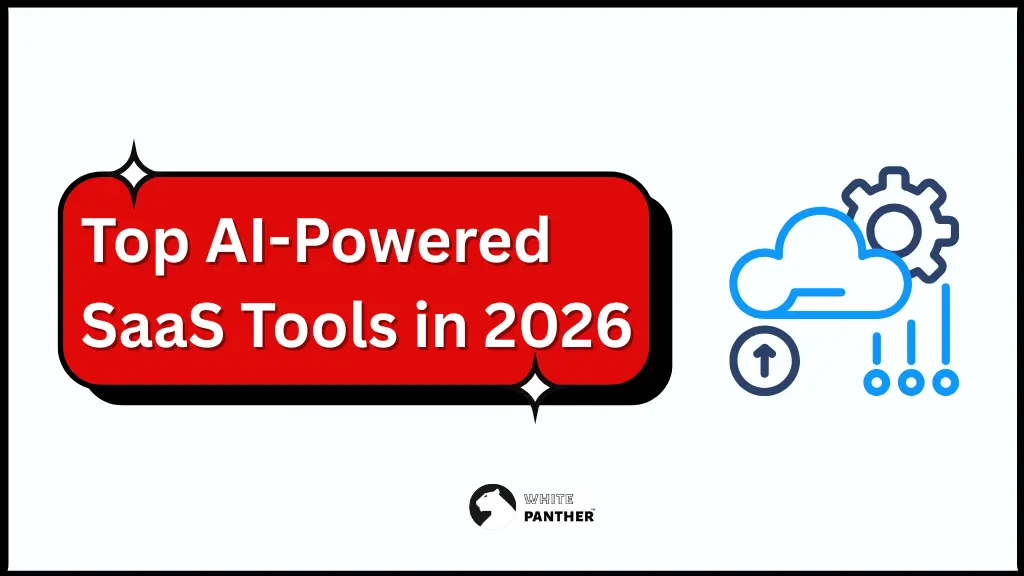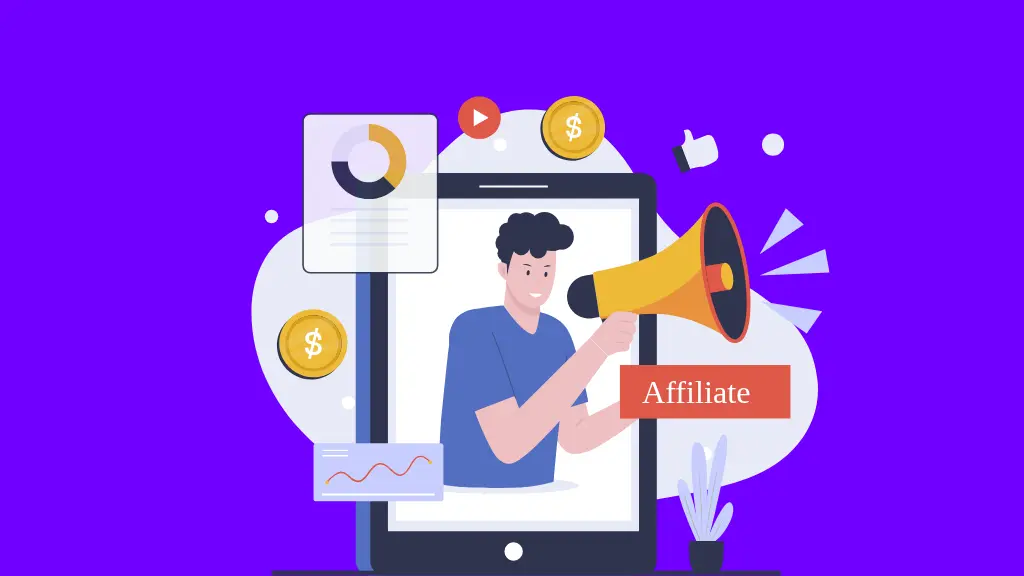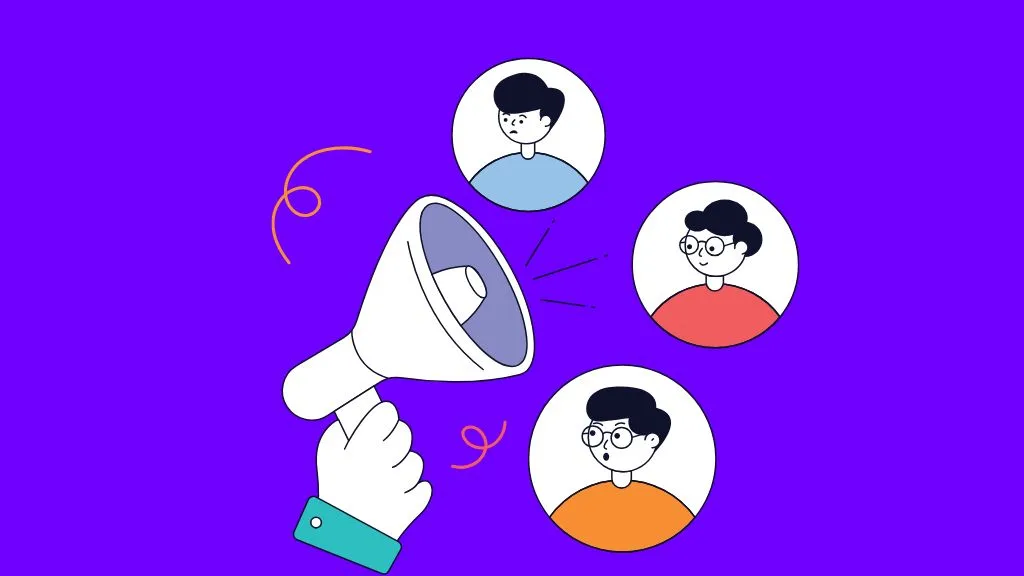Most “launch checklists” look the same.
Teaser page. Beta list. Product Hunt. Some emails.
If you follow that script, you’ll probably get a short spike and then crickets. Let’s do better.
In this article, we’ll start by understanding why launches fail, then create a SaaS product launch strategy that borrows the smartest, slightly unconventional moves from companies like Superhuman, Figma, Notion, Linear, and Slack and adapts them to your context.
Table of Contents
ToggleWhy did SaaS launches fail?
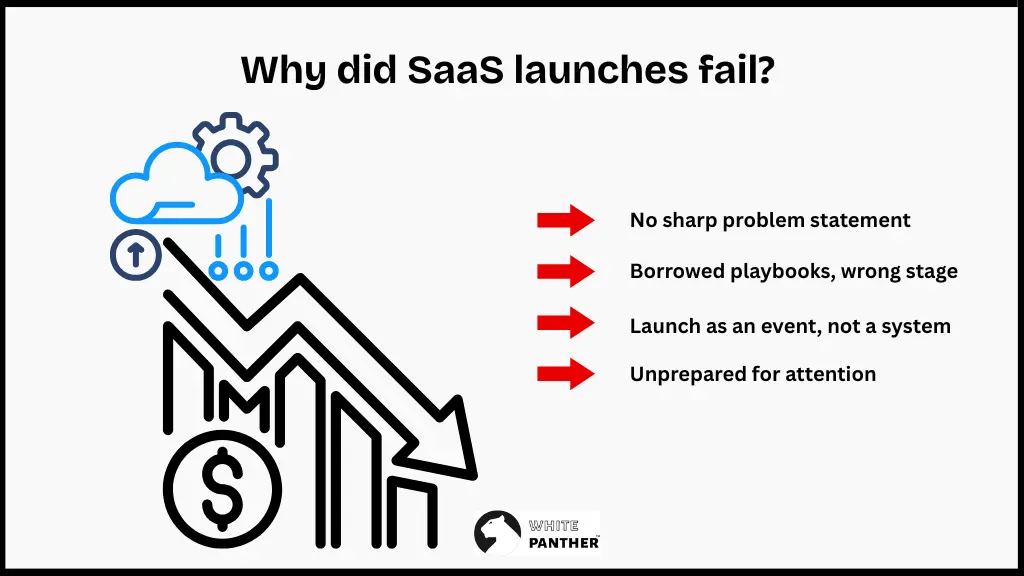
- No sharp problem statement.
Teams ship features, not a promise. If a stranger cannot repeat your one-sentence outcome after 10 seconds, your positioning is not ready. Shipping anyway is the most common failure mode.
- Borrowed playbooks, wrong stage.
Copying a mature product’s play (paid ads, heavy PR) when you are pre-fit wastes time and money. Early-stage SaaS needs intimacy and proof, not reach.
- Launch as an event, not a system.
Great teams treat launch as a sequence of mini-events before and after the “big day.” Weak teams post once and hope.
- Unprepared for attention.
Signups come in, but onboarding, support, and pricing are not ready. People bounce, and the window closes.
Now, why do you need a SaaS launch strategy guide at all?
Because a good guide stops random execution.
It aligns product, marketing, and success around a few high-leverage bets, measured week by week.
And it helps you reuse what already worked for others, without copying the parts that only worked because they were them.
Let’s get into the strategy, with concrete ideas you can steal.
SaaS launch strategy guide
Below are 10 non-generic plays you can mix and match into a SaaS product launch plan. Each comes with proof from the wild and a way to adapt to it.
1) Curate demand with a visible waitlist + human onboarding
Who did it: Superhuman.
They made access feel scarce and high touch.
Existing users could see who was waiting and refer them.
New users were onboarded in a 30-minute call that tuned shortcuts and habits to the person.
That friction created delight, a story people shared, and a strong feedback pipeline.
How you adapt it:
- Add a public or semi-public waitlist view. Show “who’s waiting” to users inside the product and give them a one-click referral.
- Replace generic tours with “founder office hours” or 20-minute onboarding calls for your first 200 users. Record common patterns and convert them into a quick start preset. Users can apply in one click.
- Message it as a perk: “We set you up so Day 1 already feels like Day 10.”
Where it fits: B2B tools that change daily workflows, email-like utilities, analytics, or any product where setup excellence is your edge.
2) Seed champions before you seed ads
Who did it: Figma.
They grew through community champions who hosted meetups, created templates, and educated teams long before a heavy sales motion.
Their community-led growth went from stealth to power users to enterprise, without using any ads.
How you adapt it:
- Identify 50 potential champions across 3 niches you want. Invite them to a closed “Builder Circle.”
- Give them three things: early access, a spotlight, and tools to teach others (slide decks, demo files, template kits).
- Build a simple “Host a 30-minute mini-workshop” kit and feature the best sessions on your site.
Where it fits:
Collaboration, design, dev tools, and any product that benefits from shared artifacts.
3) Turn your product into a template economy
Who did it: Notion.
Their template gallery and ambassador program transformed users into distributors.
People do not just use Notion; they publish Notion, which brings in new users through SEO and word of mouth.
How you adapt it:
- Ship with a “Create as template” button and a public gallery on day one.
- Run a 30-day “Template Sprint” with prizes for best templates in your top three use cases.
- Make each template page indexable and give creators a profile link. That turns your launch into a long-tail acquisition engine.
Where it fits:
Any workflow tool where repeatable setups matter: project management, CRM light, analytics, marketing automation.
4) Practice changelog-driven marketing and micro-launches
Who did it: Linear.
They treat every release like a mini event, with fast cadence, beautiful release pages, and a public changelog people actually want to read.
The result is recurring attention and a perception of relentless momentum.
How you adapt it:
- Design a consistent “release mini story or presentaion” format: 90-second clip, one story gif, three bullets, one outcome.
- Publish weekly. Post your site, you’re in-app changelog, and LinkedIn.
Where it fits:
Any product that ships often and competes on polish and speed.
5) Start bottom-up with team trials that spread
Who did it: Slack.
They famously focused on small teams first, nailed activation, and let those teams pull Slack into larger orgs.
The magic was a product that delivered value in 24 hours and a launch sequence that scored quick wins inside one account before expanding.
How you adapt it:
- Launch with a “Team of 5” challenge. Promise a measurable outcome in one week for a contained team.
- Include a built-in “invite the next squad” nudge on day 5 once the first team hits a usage milestone.
- Your sales notes should track squads inside an org, not just companies. Sell the next squad, not the whole enterprise.
Where it fits:
Horizontal tools with viral loops: messaging, docs, whiteboards, light project tools.
6) Ship a public roadmap + promise meter
Public roadmaps are not new.
What is new is turning that roadmap into a credibility engine during launch.
Linear made “build in the open” cool again for serious tools.
Others publish priorities, accept votes, and then close the loop in public, release after release.
How you adapt it:
- Publish priorities tied to named customer jobs, not feature names.
- Add a “promise meter” that shows percent complete for the top three promises you made in pre-launch.
- Every time a promise crosses a threshold, email the waitlist with a small demo and a one-click claim link.
Where it fits:
Early stage B2B where trust is a blocker, and competitors look stagnant.
7) Make access earned, not bought
Superhuman’s exclusivity shows how “earned” access can outperform discounts. People value what they invest in getting.
How you adapt it:
- Replace coupon codes with missions. Example: complete a 10-minute onboarding, invite one teammate, and connect your data source to unlock two premium features for 30 days.
- Offer priority access to users who publish a template, record a Loom case study, or answer three product questions in your forum.
Where it fits:
Prosumer and B2B were activation quality drives retention.
8) Run a problem tournament, not just a launch webinar
Most launch webinars are product tours. Flip it.
Offer a short tournament around a sharp outcome your SaaS enables.
Figma rode community challenges for years. Notion’s template contests did similar work.
How you adapt it:
- Pick one job to do. Example: “Reduce onboarding time by 30% in 7 days.”
- Create a scoreboard, provide starting templates, and stream three office hours that show real teams competing.
- Feature the winning playbooks as one-click templates and a public case library. Launch week becomes a festival, not a demo.
Where it fits:
Tools where outcomes are measurable within two weeks.
9) Treat pricing as a story device, not a table
A pricing change can be a launch if it signals your values.
Framing is the trick: free for students, community discounts, or usage-based tiers that match your narrative.
Slack and Figma both made early choices that supported bottom-up and community. (Their broader growth case studies highlight how packaging supported adoption.)
How you adapt it:
- Launch with a “Team Sprint” plan that is time-boxed rather than seat-boxed, so small teams can feel the value without procurement friction.
- Offer “maker credits” for creators who publish templates or public tutorials.
- Write a short pricing memo that explains why. People share prices; they remember stories.
10) Build a launch relay across channels instead of one big blast
Great teams chain moments. Figma moved from stealth to community to enterprise.
Linear stacks weekly micro-launches into quarterly moments. Slack seeded one team, then the next.
Your SaaS product launch marketing plan should read like a relay baton passing between events, not a single firework.
How you adapt it:
- Week −4: “Why we exist” essay and invitation to the Builder Circle.
- Week −3: Problem tournament announcement with sample templates.
- Week −2: First promise meter update and a behind-the-scenes clip.
- Week −1: Publish the public roadmap and your first three release vignettes.
- Launch week: Tournament kickoff, daily changelog posts, founder AMAs, and a rolling invite wave to waitlisters who complete missions.
- Week +1 to +4: Three customer story drops, a pricing memo, and a mini summit featuring champions. Each is a micro-launch.
Putting it together: your step-by-step SaaS Launch Strategy plan
Week −6 to −5: Sharp problem, sharp promise
- Interview with 12 target users. Write a one-line promise in their words.
- Draft a two-minute demo that proves that promise on real data.
- Pick two activation metrics that define Day-1 success.
Week −5 to −4: Champions and templates
- Hand-select 30 champions. Give them early access, a spotlight, and a “create template” challenge.
- Ship the public template gallery with profiles.
Week −4: Waitlist that works
- Open the visible waitlist and referral. Add missions that unlock early access.
- Schedule founder onboarding slots for the first 200 users.
Week −3: Promise meter and roadmap
- Publish a job-to-be-done roadmap with progress meter and voting.
- Share a behind-the-scenes post: what changed from feedback so far.
Week −2: Changelog cadence
- Start your weekly release of vignette. Post it to the site, in-app, and LinkedIn.
- Announce the problem of tournaments with prizes tied to your core job.
Week −1: Pricing as narrative
- Publish a short pricing memo. Add a team sprint plan and maker credits.
- Prep support macros, in-product nudges, and a day-one “quick win” checklist.
Launch week: The relay
- Day 1: Tournament kickoff and first invite waves to users who complete missions.
- Day 2 to 4: Founder AMAs, customer mini-stories, nightly changelog drops.
- Day 5: “What we learned this week” post and second invite wave.
- Day 6 to 7: Best tournament plays turned into templates. Feature creators.
Week +1 to +4: Convert the spike
- Three customer stories drop with before-after numbers.
- Two pricing experiments are based on usage data.
- Continue weekly vignettes. Run a second tournament for a different job.
This is not a spray-and-pray calendar. It is a chain of proof points that earn attention, turn attention into usage, and use into advocacy.
Copy-ready assets you can draft today for your SaaS product launch
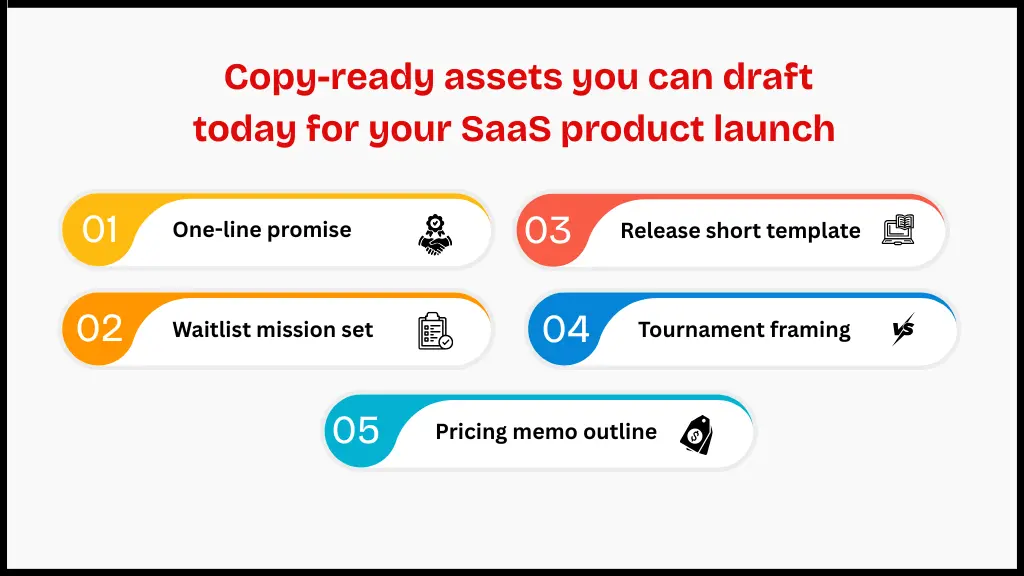
Use these to keep your SaaS product launch plan concrete.
1) One-line promise
“In 7 days, your team will [achieve outcome] without changing your stack.”
2) Waitlist mission set
- Connect your data source
- Invite one teammate
- Complete one guided task
Unlock: instant access and two pro features for 30 days
3) Release short template
- 20-second clip of the job done
- Three bullets: what changed, why it matters, what to try
- Link: “Apply this to your workspace” (fills a preset)
4) Tournament framing
Seven days. One target: cut [metric] by 30%.
We will give you the playbook, templates, and office hours. You bring a team of five.
5) Pricing memo outline
- The problem with seat-based pricing for small teams
- How our Team Sprint plan works
- Why maker credits exist
- How we will revisit this in 90 days
Frequently missed details in SaaS launches that move the needle
- Single player to multiplayer in the first session. Your onboarding should nudge a user to invite one teammate while they are having their first win. Slack mastered this. Design the nudge to appear only after the win.
- Public recognition beats private discounts. Put creator avatars on your gallery home. Notion proved people love to be seen.
- Founder time scales if you produce it. Superhuman’s manual onboarding distilled into patterns which became presets and docs. Make three live calls, then template.
- Ship rhythm creates trust. Linear’s weekly pace makes customers believe in the future of the product. Consistency matters more than size.
Conclusion
A strong SaaS product launch strategy is not about doing everything.
It is about choosing a few bold plays that create proof, stories, and momentum. Curate demand with a visible waitlist and human onboarding.
Seed champions and a template economy, so users become your distribution. Turn releases into recurring micro-launches.
Treat pricing like a story, not a table. And chain the whole thing into a launch relay that keeps compounding after the big day.
If you run this approach, your SaaS product launch marketing plan will feel different from the first touch.
People will not just see another announcement. They will see a product that knows its promise, a team that ships with rhythm, and a community that is already teaching others how to win with it.
FAQ’s
1. What is a SaaS product launch strategy?
A SaaS product launch strategy is a step-by-step plan that guides how you introduce your software to the market. It includes everything like finding your target audience, positioning your product and marketing plan, and everything.
2. How early should I start planning my SaaS launch?
Ideally, you should begin at least 6–8 weeks before launching. This gives you enough time to validate your product, build a waitlist, create marketing assets, and line up partnerships or press coverage.
3. What channels work best for a SaaS product launch?
There’s no single perfect channel; it depends on your audience. Most SaaS businesses prefer multi-channel approaches like a mix of Product Hunt, LinkedIn, email marketing, and community platforms like Indie Hackers or Reddit.
4. How do I measure the success of my SaaS launch?
Don’t just count signups. Track a mix of metrics that show both interest and retention, like waitlist conversions, Day-7 activation rate, churn rate, and user engagement during the first month. A good launch builds long-term users, not just traffic spikes.
5. What should I focus on after the launch?
After launching, shift your attention to onboarding, feedback loops, and retention. Keep releasing small updates (release vignettes), engage early adopters, and show that you’re actively improving the product. The post-launch period is where hype turns into habit.

